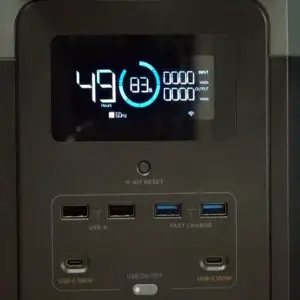The EcoFlow Delta Max portable power station is a powerful, compact unit that can provide you with extra power when you need it. However, there are some errors that may appear that you need to be ready for.
The following are the most common system errors associated with the EcoFlow Delta Max:
Error – USB-A Overload
Cause:
The USB icons flash together. This is the USB-A overload protection kicking in, due to an attached electrical device to the port.
Solution:
Remove the attached electrical device from the USB-A port and resume normal operation.
Error – USB-C Overload
Cause:
The USB icons flash together indicating the USB-C port has begun overload protection due to an attached electrical device.
Solution:
Remove the attached electrical device from the USB-C port and resume normal operation.
Error – USB-C High-Temperature Protection
Cause:
The USB icons flash together indicating the USB-C high-temperature protection has started.
Solution:
Allow the unit to cool down, and it will automatically resume normal operations.
Error – Battery Temperature Protection
Cause:
The battery icons flash together indicating high-temperature charge protection.
Solution:
Allow the battery to cool down and charging will be resumed automatically.
Error – High-Temperature Discharge Protection
Cause:
The temperature icons flash together indicating discharge protection has started.
Solution:
The battery needs to cool down and the power supply will automatically resume.
Error – Low-Temperature Charge Protection
Cause:
The temperature icons flash together.
Solution:
The battery will resume charging once the temperature rises above 41°F.
Error – Low-Temperature Discharge Protection
Cause:
The temperature icons flash together when the battery temperature falls too low.
Solution:
Once the battery temperature rises above 10°F, the power supply will resume automatically.
Error – AC Output Overload Protection
Cause:
The AC output icons flash together when the AC output overload protection kicks in.
Solution:
Remove the overload device and restart the machine. The unit will then run normally.
Error – AC High-Temperature Protection
Cause:
The AC icons flash together due to the AC high-temperature protection starting.
Solution:
The unit’s temperature needs to drop. The fan inlet and outlet may be blocked preventing the machine from cooling. If not, the machine will automatically resume normal operation.
Error – AC Low-Temperature Protection
Cause:
The AC icons flash together. This happens when the AC low-temperature protection starts.
Solution:
Make sure the unit is being used within the recommended environmental temperature range. Normal operation will resume once the unit warms up.
Error – Fan Blockage
Cause:
The Fan icon flashes due to a fan blockage.
Solution:
The fan may be blocked by a foreign object. Check the fan and remove any materials blocking it.
Error – Car Charger Overload Protection
Cause:
The car charger icons flash together when the overload protection starts.
Solution:
Remove the device connected to the car charger and then the unit will resume normal operation.
Error – Car Charger High-Temperature Protection
Cause:
The car charger icons flash together when the high-temperature protection starts.
Solution:
The unit will resume normal operation automatically when it cools down.
Error – Battery Failure
Cause:
The battery icon stays lit when the battery fails.
Solution:
Contact the EcoFlow customer service department.
If any of these errors are not resolvable, contact the manufacturer or dealer for further assistance.


